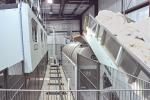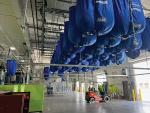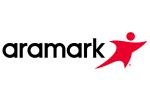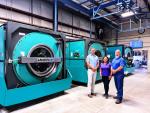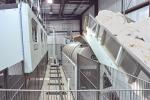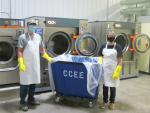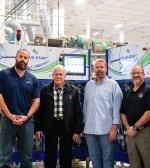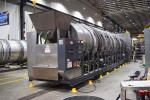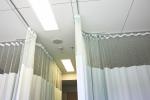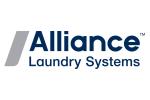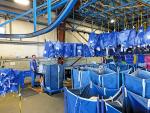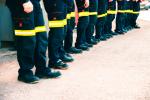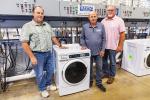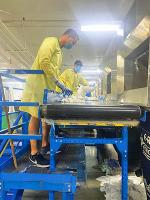Uniforms/Workwear Manufacturing: Scott Delin, Fashion Seal Healthcare, Seminole, Fla.

Baby it’s cold outside! That was the battle cry this most recent Christmas holiday week when our daughter was home for the holiday visiting from Florida.
For those of you who were not impacted by this unusual polar vortex, temperatures here in Northeast Pennsylvania with wind chill were at a balmy -25 F.
Unbelievably, we even had ice forming on the inside of our windows. With those abnormal temperatures, our daughter with her blood having thinned out by living in Florida began her search in our house for the space heater we had in storage to help add some warmth to her bedroom.
Once her search was complete, without removing the dust collected from not being used over the years since she relocated to the land of sun and warm weather, she happily plugged the rarely used space heater into the electrical socket.
Soon after the magical warming unit was plugged in, sparks started to fly as the dust balls gathered on and inside the filters caught fire.
On seeing sparks and smelling smoke, I started to think about what are we, as laundry operators, doing to prevent fires and small stupid electrical incidents in our plants?
What are we as laundry operators doing to keep our employees warm and safe during these cold winters while at work or even at their homes?
What are we as laundry operators doing to educate our service team and our customers on proper storage of product so as to not place it in areas that may cause unexpected fires?
Every laundry must have a safety team in place with a checklist that is given its utmost attention to detail. The safety team should set a schedule for when to meet to discuss all items of concern that are dealt with and corrected on a timely basis.
To avoid fires in the plants, it is the responsibility of our safety and top-notch maintenance teams to make sure the air filters are changed and replaced regularly.
That we have in place procedures that require blowing down and removing all dust and lint that tends to build up on machinery, overhead pipes, and even in some cases, inventory in our storage areas.
Also, let us not forget the roofs on top of our buildings. We need to make sure any possible lint buildup is removed as well, as we have seen fires start on rooftops from gathered lint never removed.
By checking these few little steps off our checklist, we are taking the possibility of any lint fires out of the equation.
Also, being a realist, some laundry operators have cold spots in their plants, and employees have been known to plug in space heaters to keep them warm at work during the cold months.
In these cases, we need to make sure there is no lint gathered on the heaters and also that these heaters are not close to anything considered to be a combustible item that can cause a spark that can turn into a fire.
Is there any way heat or steam being vented out of our buildings be recycled back into the building? If so, we should do so. Not only will this help keep the temperatures at a comfortable working level, but it will also add to a more environmentally friendly workplace.
What about our fleet of trucks? If parked inside the building, do they need to be plugged into wall sockets so engine blocks do not freeze during the cold weather? If so, we need to make sure wires are all properly grounded so there is no chance of any possible sparks that can also be the culprit of an unsolicited electrical fire.
Let us not forget about our employees and our customers. We also need to educate them on ways to keep warm at home by changing air filters and if they are using space heaters, not to place them near curtains or anything that can catch fire easily.
If they have wood-burning fireplaces in their homes or places of work, make sure they have proper ventilation and make sure there is no chance of any sparks being emitted from the fireplace that can cause a fire. A little education goes a long way to preventing fires.
We should also consider empowering our employees to report all fire and safety hazards every week to the safety committee so they can be dealt with immediately.
Those who take part in this process should have their names entered into a weekly lottery to possibly win a prize or even a small bonus. By doing this we create a safer workplace, increase morale and have many eyes keeping watch to prevent unwarranted fires.
Oh, and by the way, right after the Christmas holiday our daughter was back in her car driving back to the land of sun and fun. She did arrive safely and the last time we spoke, she was hanging out at her pool sipping a cold drink. I am so jealous.
As a wise bear once said, only you can prevent fires!
Chemicals Supply: John Schafer, Diversey, Fort Mill, S.C.

You must commit yourself and your managers to a culture of safety to get your employees to also do so.
Your commitment to safety needs to be visible for your customers to also follow suit.
Safety needs to be an integral part of your company’s culture. Using laundry fires as an example, here is what you can do:
- Train your staff on the location and use of fire extinguishers.
- Don’t overload your dryers.
- Always use cool down.
- Don’t stuff laundry carts with either washed or dirty linen and let them sit overnight—spontaneous combustion could occur.
- Empty dryers at the end of the day.
- Clean lint traps after each load.
- Ensure your laundry is clean and free of lint—clean daily.
- Make sure your dryers are maintained properly.
- If the linen smells of grease or oil after washing—do not dry—wash again.
Doing these things will show your employees your commitment to safety and communicate why the buildup of lint can cause fires and linen left in carts can spontaneously combust.
Discuss safety at employee meetings. Provide updates on where you are with safety. Solicit feedback and suggestions from your employees on how to be safer.
Invite experts to talk about safety and give training. Chemical use is one—your vendor can provide proper chemical use training and explain SDS sheets.
Ensure your employees have proper attire and PPE for the jobs they are doing. Again, with chemicals use, your chemical vendor can assist with this.
Remember a safe business is good for business.
Consulting Services: Cliff Beiser, Champions Touch, Kissimmee, Fla.

I was walking around at the Clean Show ’22 and visited a booth on insurance for laundry and was asked the question whether I did any F&B.
If the answer was yes, due to the grease, they would not be interested in covering me unless I provided very detailed information on how I was handling and pretreating the napkins and kitchen rags.
This certainly indicates how prevalent and important potential laundry fires are to each owner.
In Grainger’s list of the top 10 OSHA violations of 2022, fall protection is No. 1 just as it was in 2021, 2020, 2019, etc. We work in a water-rich environment, so there cannot be too much attention paid to slip-and-fall accidents.
Extra signage, safety shoes, rags, and mops at the ready, and daily inspections for any machine leakage, should be “top of mind.”
We need to show how much we care for our staff and customers by training them and protecting them. It is to the business’ advantage in a financial sense as well due to the large claims that are paid out annually and, on the back end, larger insurance bills due to the accident.
In addition, create a positive attitude by putting safety in a primary position of importance with a program with employees. Contests with simple rewards work very well.
I have seen some have a “safety wall” and saw one large laundromat with a PPE (personal protection equipment) vending machine for both employees and customers.
Of course, making sure that all communication is in the language(s) of both our employees and customers is vital. You might even have a trusted employee give a short presentation on how being safe has impacted them.
Having our staff read and sign, “A Job Hazard Analysis (JHA) form is an excellent means of emphasizing safety’s importance in our business. Job Hazard Analysis (JHA) is a method for identifying and evaluating hazards associated with tasks (steps) with a specific job or activity and eliminating or mitigating them prior to conducting work.” (This can be found via Google.)
How can I reduce the risk of fire in my laundry room?
Not once a month, or even once a week, “Clean the lint from the dryer’s lint screen after every load,” says Richard Handel, the test engineer who oversees CR’s laundry appliance lab.
“This helps prevent a fire, and it also helps your laundry dry faster.”
At the end of the day, take a walk around the business. Look for signs of fire risks, signs of smoke or scorching. If so, you may need to take certain equipment out of service for a time.
This summer I stayed at a hotel, and they had their employee smoking area outside the laundry with a table and ashtrays set up right next to the dryer vents!
The overriding point is that fire and standing water safety in and around the laundry is a constant item for concern, inspection and action.
Click HERE to read Part 1 with advice from experts in textile/uniform rental, equipment manufacturing and equipment/supply distribution.
Have a question or comment? E-mail our editor Matt Poe at [email protected].




















































